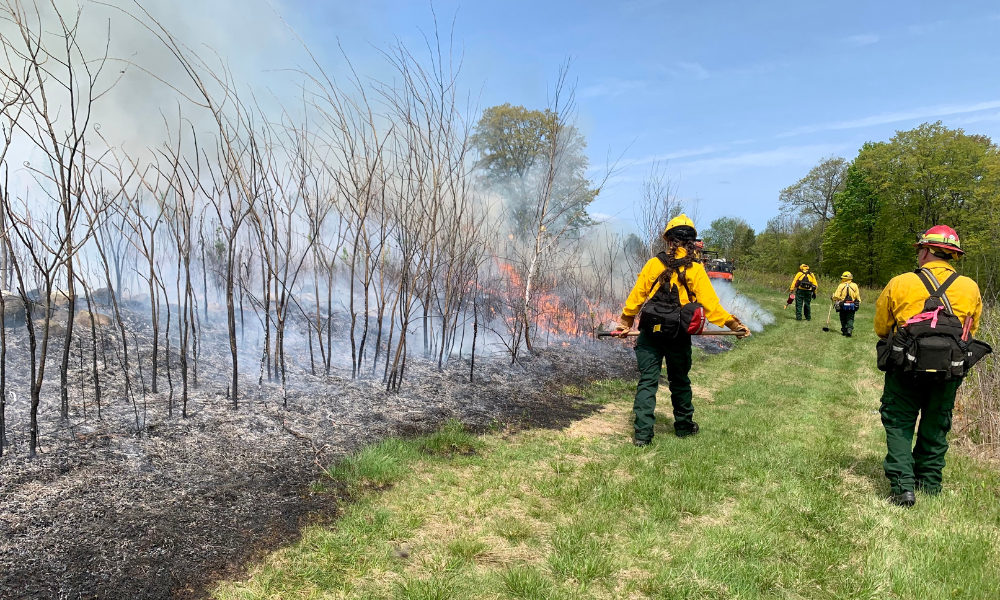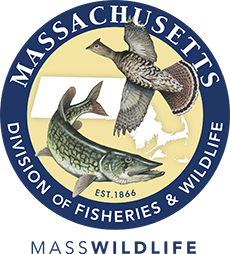- Division of Fisheries and Wildlife
Media Contact
Media Contact, MassWildlife

MassWildlife and other agencies in the Northeast are using prescribed fire more frequently as a habitat management tool to benefit rare and declining wildlife and plants. You might not realize that many game species like deer and turkey also benefit from prescribed fire.
Fire is an ancient and proven habitat management tool, used by people all over the world. There are many reasons people have used fire on the land, one of which was to improve habitat for game species. This use of fire fostered a reciprocal relationship where the fire enhanced habitat conditions for game populations to thrive and people were able to harvest some of that game. Today’s use of prescribed fire by MassWildlife is no different; it provides immense benefits to declining species, as well as common game species that can be hunted.
Prescribed fire is used to manage and maintain open habitats like grasslands, pine barrens, and oak woodlands where a lot of sunlight can reach the ground and promote vigorous growth of native understory vegetation. It is this “ground” vegetation that provides animals the critical resources of natural food and cover throughout the year at the level where they can use it.
For white-tailed deer, fire-maintained habitats provide important resources during some of the most critical parts of their lives. The abundant mix of shrubs, grasses, and herbaceous vegetation on the ground provide cover for fawns to hide and evade predators while a diverse mix of flowering plants ensure optimal summer nutrition for fawns to grow quickly. In the fall, those flowering plants develop fatty, protein rich seeds that deer consume to add on weight for winter survival. Fire rejuvenates this ground vegetation and burns up the competition, like tree saplings, that would have eventually shaded these plants out if left unchecked.
The wild turkey’s most crucial life stage is during nesting and poult rearing. Fire-maintained habitats provide excellent cover on the ground to hide not only the eggs but the hen when she’s sitting on the nest. Once the eggs hatch, the turkey poults depend exclusively on protein-rich insects. The more insects available, the faster the poults can grow, evade predators, and ultimately survive. Fire promotes a diversity of ground vegetation that then supports an abundance of insects, exponentially more than a shaded forest. Fire also removes the dense thatch allowing turkey poults to move easily when foraging for insects while native vegetation provides overhead protection from avian predators. At Wildlife Management Areas (WMAs), where MassWildlife uses prescribed fire to manage a diversity of habitats across a large landscape, game animals like turkeys have a variety and abundance of food, nesting, and roosting resources throughout the year. Having all these options reduces the turkeys’ need to travel far which significantly limits their chances of run-ins with a predator or a car.
The use of fire to maintain and improve habitats has incredible benefits to game species and the hunters that pursue them. Not only are these lands more productive for game, but the diversity of open habitats just makes them plain fun and exciting places to hunt. If you’d like to explore a WMA where prescribed fire and many other habitat management practices have been used, visit:
- Montague Plains WMA – Montague, get info | go to map
- Herman Covey WMA – Belchertown, get info | go to map
- Quaboag WMA – Brookfield, get info | go to map
- Birch Hill WMA – Winchendon, get info | go to map
- Frances Crane WMA – Bourne and Falmouth, get info | go to map
- Noquochoke WMA, Dartmouth - get info | go to map
Check out mass.gov/prescribedfire to learn more about the use of planned fire to manage healthy habitats. Visit this webpage for a complete list of sites where MassWildlife will be conducting prescribed fires this year.
